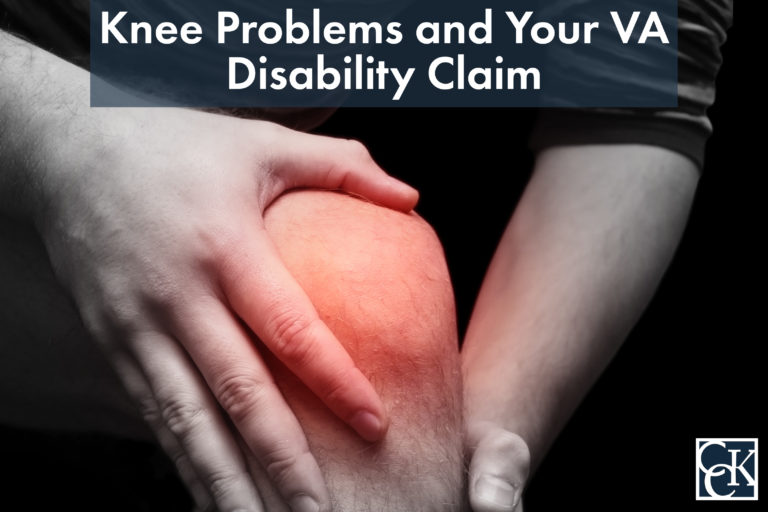Knee Problems and Your VA Disability Claim

CCK Law: Our Vital Role in Veterans Law
Veterans commonly file service-connected disability claims for knee problems. According to the VA 2024 Annual Benefits Report, “limitation of flexion, knee” is the second most common service-connected disability of new compensation recipients. Over 153,000 veterans receive disability compensation for this issue. In total, over two million veterans receive VA compensation for this condition.
In this article, CCK Law will discuss:
- Getting service connection for knee problems
- How VA rates the conditions of the knees
- Compensation and Pension Exams
- And more
How to Get VA Disability for Knee Conditions
Service connection refers to a definitive link between your military service and your injury. Veterans can establish service connection for a knee condition through one of the following ways:
Direct Service Connection
To prove direct service connection, veterans must show that their knee injury is a clear result of an event, injury, or illness that occurred during service. This requires evidence of three things:
- A current medical diagnosis of a knee condition;
- An in-service event, illness, or injury; and
- A nexus, or link, between your knee condition and the event, illness, or injury during service.
For example, say you worked as a paratrooper during your military tours. You landed incorrectly during one of your jumps and required a knee replacement. Your service and medical records should then show evidence of this link.
Secondary Service Connection
In some cases, a veteran’s knee injury may not be the direct result of an in-service event. Instead, it may have developed due to another service-connected condition. Secondary service connection for knee conditions generally requires:
- A current medical diagnosis of a knee condition, and
- A nexus between your knee condition and your service-connected condition.
For example, if your service-connected spine injury caused you to develop a knee injury, this can be the basis for establishing secondary service connection.
Aggravation of Preexisting Conditions
If you had a preexisting knee condition that then worsened due to an in-service event or injury, you may also be able to obtain VA disability compensation. You can consult medical records from before, during, and after service to see if a specific injury or activity worsened your preexisting knee injury.
VA Disability Ratings for Knee Conditions
Once your knee injury is service-connected, VA will assign a disability rating ranging between 0 and 100 percent. VA evaluates knee conditions under 38 CFR § 4.71a, using several different diagnostic codes (DCs). Generally, greater restrictions in the knee joint’s range of motion lead to a higher disability rating.
Overall, VA knee ratings depend on various factors, such as:
- The type of knee injury
- The severity of the diagnosed knee condition
- The knee’s range of motion
- The pain it causes
Some knee problems may seem to fit under the rating criteria of multiple diagnostic codes. However, it is important to avoid pyramiding – VA’s term for rating the same disability, or same manifestation (i.e., symptom) of a disability, twice. In this situation, it may be beneficial to talk to an accredited representative to learn more about which disability ratings are appropriate for your knee condition(s).
VA Knee Rating Chart
The following are several common knee conditions among veterans and how VA rates them under their diagnostic codes.
Ankylosis of the Knee – DC 5256
Ankylosis (i.e., abnormal stiffening and immobility) of the knee can be assigned a 30, 40, 50, or 60 percent disability rating depending on the limitation of flexion. The rating criteria are as follows:
- 60% – Extremely unfavorable, in flexion at an angle of 45 degrees or more
- 50% – In flexion between 20 and 45 degrees
- 40% – In flexion between 10 and 20 degrees
- 30% – Favorable angle in full extension, or in slight flexion between 0 and 10 degrees
Other Impairment of the Knee – DC 5257
Here, the rating criteria are based on the extent of the “recurrent subluxation or lateral instability” a veteran experiences in their knee. Subluxation refers to the dislocation of the kneecap while lateral instability refers to the knee giving out.
Below are the rating criteria for recurring subluxation or instability of the knee:
- 30% – Unrepaired or failed repair of complete ligament tear causing persistent instability.
- Additionally, a medical provider must prescribe both an assistive device, such as a cane, crutch, or walker, as well as bracing for ambulation.
- 20% – One of the following criteria must be met:
- Sprain, incomplete ligament tear, or complete ligament tear causing persistent instability.
- A medical provider must also prescribe a brace and/or assistive devices such as a cane, crutch, or walker, or bracing for ambulation.
- Unrepaired or failed repair of complete ligament tear, causing persistent instability.
- A medical provider must also prescribe assistive devices such as a cane, crutch, or walker, and/or bracing for ambulation.
- Sprain, incomplete ligament tear, or complete ligament tear causing persistent instability.
- 10% – Sprain, incomplete ligament tear, or complete ligament tear (repaired, unrepaired, or failed repair) causing persistent instability.
- A medical provider does not need to prescribe assistive devices such as a cane, crutch, or walker, or bracing for ambulation to receive this rating.
Another impairment of the knee rated under this diagnostic code is patellar instability. Patellar instability occurs when the kneecap, or the patella, is moved or displaced from its intended resting place.
A kneecap without impairment typically rests in a groove called the trochlea near the end of the thigh bone, or femur. When the patella is pushed completely out of this groove, the patella becomes dislocated. When the patella is pushed partially out of the groove, it is referred to as subluxation. Below are the rating criteria for patellar instability:
- 30% – A diagnosed condition involving the patellofemoral complex with recurrent instability.
- A medical provider must prescribe both an assistive device, such as a cane, crutch, or walker, as well as bracing for ambulation.
- 20% – A diagnosed condition involving the patellofemoral complex with recurrent instability.
- A medical provider must prescribe one of the following: a brace, cane, or walker.
- 10% – A diagnosed condition involving the patellofemoral complex with recurrent instability (with or without history of surgical repair).
- A medical provider does not need to prescribe assistive devices such as a cane, crutch, or walker, or bracing for ambulation to receive this rating.
It is important to note that the patellofemoral complex refers to the quadriceps tendon, the patella, and the patellar tendon. For the purposes of the rating criteria, a surgical procedure that does not involve one of these (quadriceps tendon, patella, or patellar tendon) cannot qualify as surgical repair for patellar instability. For example, arthroscopy to remove loose bodies and joint aspiration does not qualify as surgical repair for patellar instability.

Limitation of Flexion of the Knee – DC 5260
Limitation of flexion of the knee, the most common service-connected knee condition, refers to the range of motion of the knee as the veteran moves it or curls it inward towards the body. The rating criteria are as follows:
- 30% – flexion limited to 15 degrees
- 20% – flexion limited to 30 degrees
- 10% – flexion limited to 45 degrees
- 0% – flexion limited to 60 degrees
Limitation of Extension of the Knee – DC 5261
The limitation of extension of the knee refers to an individual’s ability to straighten their knee. VA evaluates this condition as follows:
- 50% – extension limited to 45 degrees
- 40% – extension limited to 30 degrees
- 30% – extension limited to 20 degrees
- 20% – extension limited to 15 degrees
- 10% – extension limited to 10 degrees
- 0% – extension limited to 5 degrees
Knee Replacement (Prosthesis)
If a veteran’s knee condition progresses, they may need to undergo a knee replacement. Knee replacements can be total or partial, which are both rated the same by VA under diagnostic code 5055. Specifically, total and partial knee replacements are evaluated as follows:
- 100% – For four months following implantation of prosthesis or resurfacing. After the four-month period, the knee will be re-evaluated for a permanent rating.
- 60% – With chronic residuals consisting of severe painful motion or weakness.
- 30% – With intermediate degrees of residual weakness, motion, or limitation of motion.
For the minimum 30 percent disability rating, VA should also look to other diagnostic codes related to knee conditions to see if the veteran is entitled to a higher evaluation.
What to Expect During a Knee C&P Exam
When evaluating your knee disability, VA may schedule a Compensation & Pension (C&P) exam. C&P exams are typically conducted by VA health care providers or VA-contracted providers. The purpose of the exam is to determine whether your knee disability is related to your service. To do this, the examiner may ask you questions regarding your service or knee disability, review your file, or perform a physical exam.
Since VA often rates knee conditions based on range of motion, VA examiners frequently use a tool called a goniometer to measure range of motion. In some instances, the examiner may determine that there is enough documentation to evaluate the condition without a physical exam.
After the examination, the VA examiner will decide if your knee disability is “at least as likely as not” connected to your service. If you receive an opinion you disagree with, you can acquire a private physician or doctor’s opinion to refute the findings.
It is important to note that VA does not provide copies of C&P exams unless specifically asked, so veterans will want to be sure to request a copy.
TDIU for Knee Conditions
If you are unable to work because of your knee problems, you may be entitled to Total Disability based on Individual Unemployability (TDIU). To qualify for TDIU, you must show that your knee disability prevents you from obtaining and maintaining substantially gainful employment. If you are granted TDIU, you will be paid monthly VA benefits at the 100 percent level.
Was Your VA Disability Claim for a Knee Condition Denied?
If VA denied you benefits for your knee condition and you need assistance filing an appeal, Chisholm Chisholm & Kilpatrick may be able to help. Our veterans’ law practitioners have decades of experience helping veterans secure the benefits they deserve. We know what it takes to put together a winning appeal, and we want to put our tools, resources, and successful history to work for you. Call CCK at 800-544-9144 for a free case evaluation.
About the Author
Share this Post
